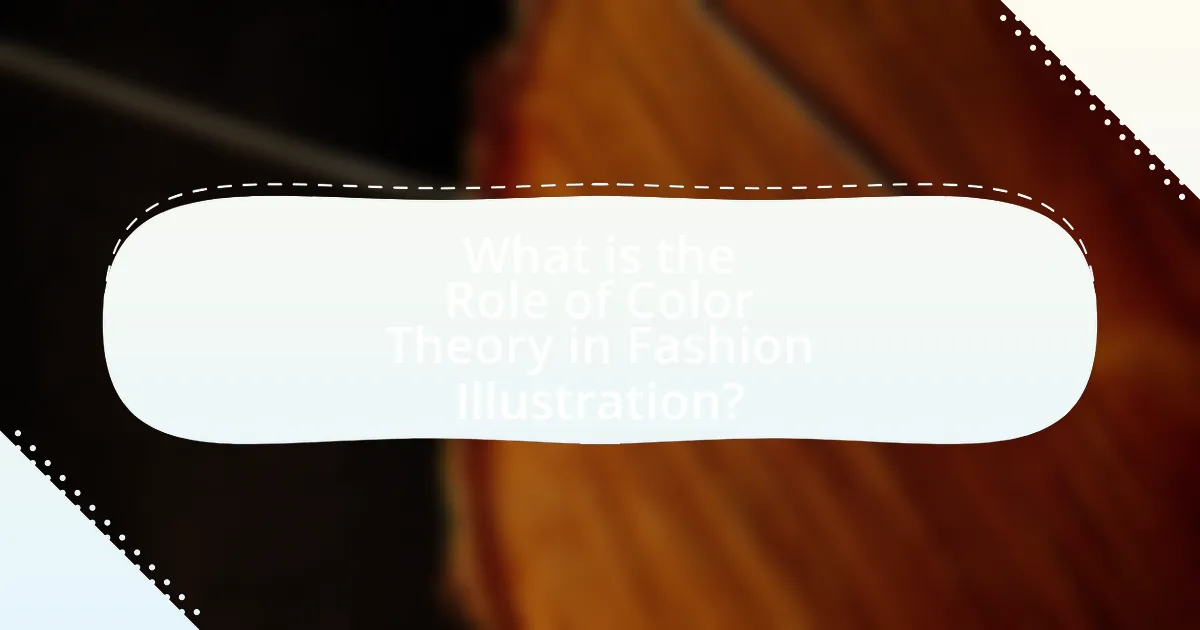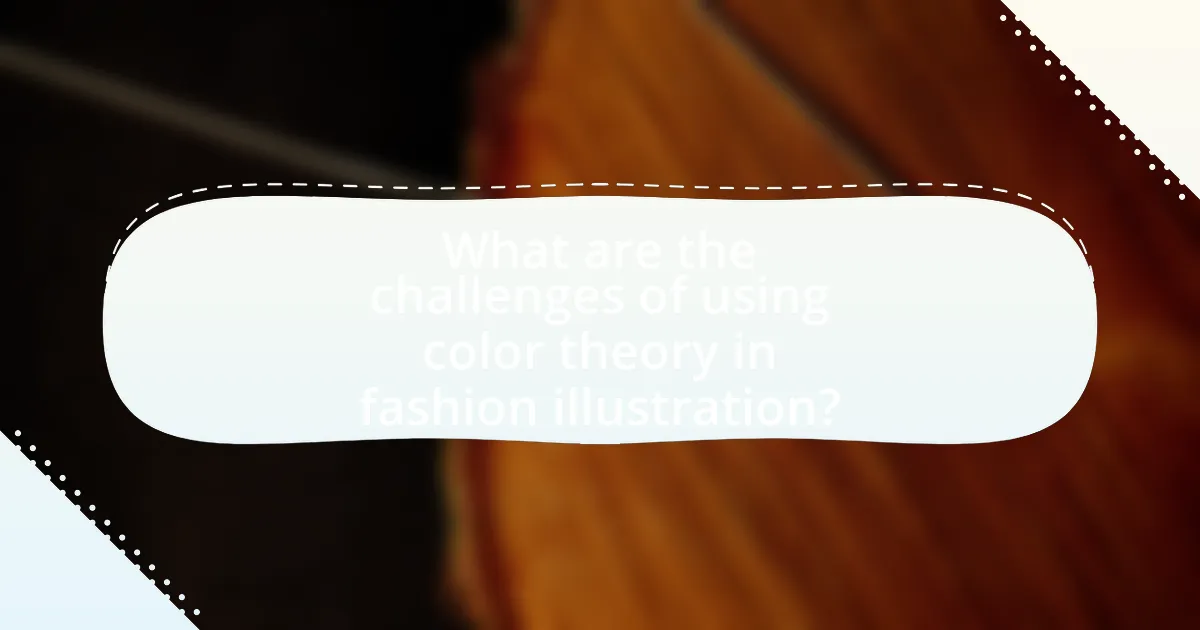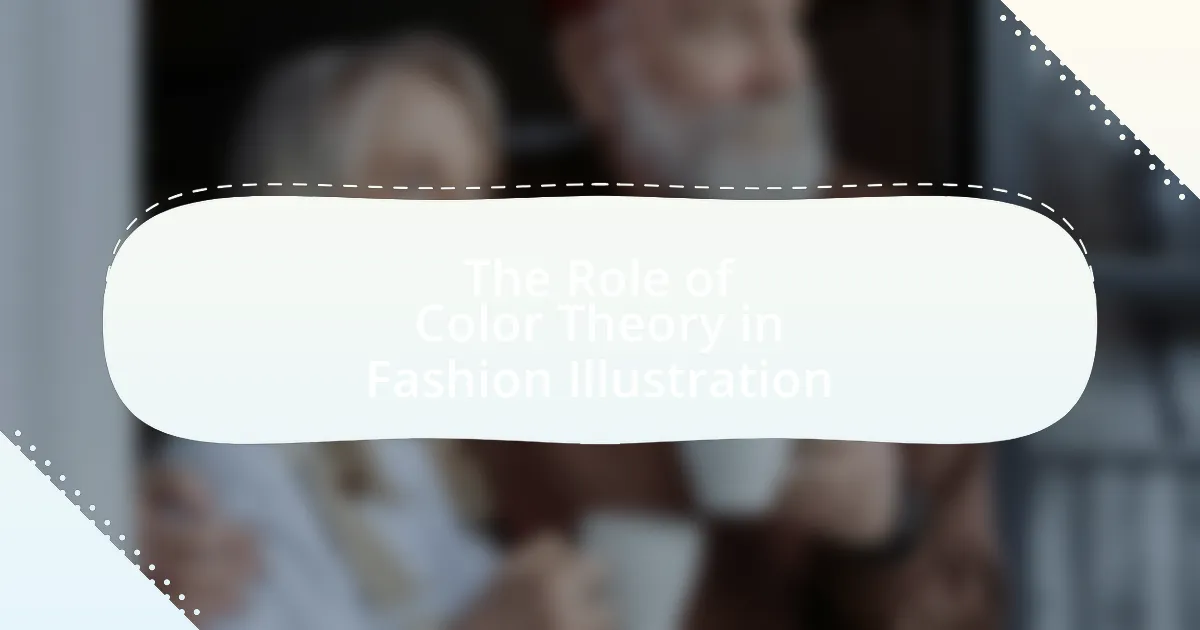The article focuses on the role of color theory in fashion illustration, emphasizing its importance in selecting and combining colors to convey mood, style, and brand identity. It explores how color harmonies, such as complementary and analogous schemes, enhance visual appeal and emotional resonance in designs. Key principles of color theory, including the psychological effects of colors and the use of color palettes, are discussed, along with techniques illustrators employ to implement these concepts effectively. The article also addresses the challenges and common mistakes in applying color theory, providing strategies for improvement and best practices for achieving impactful fashion illustrations.

What is the Role of Color Theory in Fashion Illustration?
Color theory plays a crucial role in fashion illustration by guiding the selection and combination of colors to convey mood, style, and brand identity. Effective use of color can evoke emotions and influence consumer perception, as evidenced by studies showing that color can increase brand recognition by up to 80%. Additionally, color theory helps illustrators create visual harmony and contrast, enhancing the overall aesthetic appeal of their designs. By understanding color relationships, such as complementary and analogous colors, fashion illustrators can create more dynamic and engaging illustrations that resonate with their audience.
How does color theory influence fashion illustration?
Color theory significantly influences fashion illustration by guiding the selection and combination of colors to evoke specific emotions and convey messages. Fashion illustrators utilize color harmonies, such as complementary and analogous schemes, to create visually appealing designs that resonate with the intended audience. For instance, warm colors like red and orange can evoke feelings of excitement and energy, while cool colors like blue and green often convey calmness and sophistication. This strategic use of color not only enhances the aesthetic quality of illustrations but also aligns with fashion trends and cultural contexts, as seen in the seasonal color palettes established by organizations like Pantone.
What are the fundamental principles of color theory?
The fundamental principles of color theory include the color wheel, color harmony, and the psychological effects of color. The color wheel, developed by Isaac Newton, organizes colors into primary, secondary, and tertiary categories, providing a visual representation of relationships between colors. Color harmony refers to the aesthetically pleasing combinations of colors, which can be achieved through various schemes such as complementary, analogous, and triadic. The psychological effects of color highlight how different colors can evoke specific emotions and responses, influencing perceptions and behaviors. These principles are essential in fashion illustration, as they guide designers in creating visually appealing and emotionally resonant works.
How do color harmonies affect fashion illustrations?
Color harmonies significantly influence fashion illustrations by enhancing visual appeal and conveying specific emotions. When illustrators utilize complementary, analogous, or triadic color schemes, they create a cohesive and striking representation of fashion designs. For instance, complementary colors can generate a vibrant contrast that draws attention, while analogous colors provide a more harmonious and soothing effect. Research indicates that color combinations can evoke emotional responses; for example, warm colors often elicit feelings of excitement and energy, while cool colors tend to promote calmness and relaxation. This understanding of color harmonies allows fashion illustrators to effectively communicate the intended mood and style of their designs, ultimately impacting viewer perception and engagement.
Why is color selection important in fashion illustration?
Color selection is crucial in fashion illustration because it influences the emotional response and perception of the design. The choice of colors can evoke specific feelings, convey brand identity, and enhance the overall aesthetic appeal of the illustration. For instance, studies show that colors like red can evoke excitement, while blue often conveys calmness. This psychological impact of color is supported by research from the Institute for Color Research, which indicates that people make a subconscious judgment about a person, environment, or product within 90 seconds of initial viewing, and between 62% to 90% of that assessment is based on color alone. Therefore, effective color selection not only enhances visual communication but also plays a significant role in attracting and engaging the target audience in fashion illustration.
What psychological effects do colors have on viewers?
Colors significantly influence viewers’ emotions and perceptions. For instance, red often evokes feelings of passion and urgency, while blue tends to promote calmness and trust. Research by Andrew Elliot and Markus Maier in their study “Color and Psychological Functioning: A Review of Theoretical and Empirical Work” published in 2014 highlights that warm colors like red and yellow can increase energy levels, whereas cool colors like green and blue can enhance relaxation and focus. This understanding of color psychology is crucial in fields such as fashion illustration, where color choices can affect consumer behavior and emotional responses to designs.
How can color choices enhance the mood of an illustration?
Color choices significantly enhance the mood of an illustration by evoking specific emotions and setting the overall tone. For instance, warm colors like red and orange can create feelings of excitement or warmth, while cool colors such as blue and green often convey calmness or tranquility. Research in color psychology supports this, indicating that colors can influence human emotions and perceptions; for example, a study published in the journal “Color Research and Application” found that red can increase feelings of arousal and energy, while blue tends to promote relaxation. Thus, the strategic use of color in fashion illustration not only captures attention but also communicates the intended emotional message effectively.

How do fashion illustrators apply color theory in their work?
Fashion illustrators apply color theory by strategically selecting color palettes that evoke specific emotions and enhance the visual appeal of their designs. They utilize concepts such as complementary colors to create contrast and harmony, which can draw attention to key elements of their illustrations. For instance, the use of warm colors can convey energy and excitement, while cool colors often evoke calmness and sophistication. This application of color theory is supported by research indicating that color can significantly influence consumer perception and behavior in fashion, as seen in studies by researchers like Andrew Elliot and Markus Maier, who found that color affects mood and decision-making.
What techniques do illustrators use to implement color theory?
Illustrators implement color theory through techniques such as color harmony, contrast, and the use of color palettes. Color harmony involves selecting colors that complement each other, creating a visually appealing composition; for example, analogous colors are often used to evoke a sense of unity. Contrast is utilized to draw attention to specific elements, with complementary colors enhancing visual interest and depth. Additionally, illustrators often create color palettes based on color schemes like monochromatic, triadic, or tetradic arrangements, which guide their choices and ensure a cohesive look. These techniques are grounded in the principles of color theory, which emphasize the psychological and emotional impacts of color combinations on viewers.
How do illustrators create color palettes for their designs?
Illustrators create color palettes for their designs by selecting colors that evoke specific emotions and harmonize with the overall theme of their artwork. They often begin by researching color theory principles, such as complementary and analogous colors, to ensure visual balance and appeal. Additionally, illustrators may use digital tools like Adobe Color or color wheel applications to experiment with various combinations and visualize how colors interact. This method allows them to refine their choices based on the intended mood and message of the design, ensuring that the final palette effectively communicates the desired aesthetic.
What role does contrast play in fashion illustrations?
Contrast plays a crucial role in fashion illustrations by enhancing visual interest and emphasizing key design elements. By juxtaposing different colors, textures, and shapes, artists can create a dynamic composition that draws the viewer’s attention to specific areas, such as clothing details or accessories. For instance, using complementary colors can make certain features pop, while varying line weights can add depth and dimension. This technique not only aids in storytelling within the illustration but also aligns with color theory principles, where contrast is essential for creating harmony and balance in visual art.
How does color theory impact the perception of fashion trends?
Color theory significantly influences the perception of fashion trends by guiding designers in selecting color combinations that evoke specific emotions and responses. For instance, warm colors like red and orange can create feelings of excitement and energy, while cool colors such as blue and green often convey calmness and tranquility. Research indicates that color choices can affect consumer behavior; a study published in the Journal of Fashion Marketing and Management found that 85% of consumers make purchasing decisions based on color alone. This demonstrates that understanding color theory allows fashion designers to align their collections with the emotional and psychological responses they aim to elicit from their audience, thereby shaping trends effectively.
What colors are currently trending in the fashion industry?
Currently, colors trending in the fashion industry include vibrant shades such as electric blue, rich emerald green, and soft pastels like lavender. These colors have been highlighted in recent fashion weeks and collections, reflecting a shift towards bold and expressive palettes. For instance, the Pantone Color Institute’s Fashion Color Trend Report for Spring/Summer 2023 identified these hues as key influences, showcasing their prevalence in designer collections and runway shows.
How do seasonal color trends influence fashion illustrations?
Seasonal color trends significantly influence fashion illustrations by dictating the palette that designers and illustrators use to convey the mood and style of each season. For instance, Pantone, a leading color authority, releases a Color of the Year and seasonal palettes that reflect cultural trends, which illustrators incorporate into their work to align with current consumer preferences. This alignment not only enhances the visual appeal of the illustrations but also ensures that they resonate with the target audience, as seen in the adoption of earthy tones in fall collections or vibrant pastels in spring. By adhering to these trends, fashion illustrations effectively communicate the essence of the season, making them more relevant and appealing to consumers.

What are the challenges of using color theory in fashion illustration?
The challenges of using color theory in fashion illustration include the subjective nature of color perception, the complexity of color combinations, and the influence of cultural associations. Color perception varies among individuals, meaning that what appears harmonious to one person may not resonate the same way with another. Additionally, creating effective color combinations requires a deep understanding of color relationships, which can be difficult for illustrators to master. Cultural associations with colors can also complicate the use of color theory, as certain colors may evoke different emotions or meanings in different cultures, potentially leading to misinterpretation of the intended message in the illustration.
What common mistakes do illustrators make with color theory?
Illustrators commonly make mistakes with color theory by failing to understand color harmony, which can lead to unappealing color combinations. Many illustrators neglect the importance of complementary colors, resulting in designs that lack visual interest and balance. Additionally, some illustrators misuse saturation and brightness, creating images that are either too dull or overly vibrant, which can detract from the intended message. Research indicates that color perception significantly influences viewer emotions and reactions, highlighting the necessity for illustrators to apply color theory effectively to enhance their work.
How can poor color choices affect the overall design?
Poor color choices can significantly undermine the overall design by creating visual discord and failing to convey the intended message. When colors clash or do not harmonize, they can distract the viewer, leading to confusion and a negative emotional response. For instance, research indicates that color combinations can influence perceptions of brand identity; a study by Labrecque and Milne (2013) found that inconsistent color usage can diminish brand recognition by up to 80%. Additionally, poor color choices can affect readability and accessibility, making it difficult for audiences to engage with the design effectively. Thus, selecting appropriate colors is crucial for achieving a cohesive and impactful design in fashion illustration.
What strategies can illustrators use to avoid color pitfalls?
Illustrators can avoid color pitfalls by employing a limited color palette, utilizing color harmony principles, and conducting thorough color tests. A limited color palette helps maintain consistency and prevents overwhelming the viewer with too many colors. By applying color harmony principles, such as complementary or analogous color schemes, illustrators can create visually appealing compositions that enhance the overall design. Conducting color tests, including digital mock-ups or physical swatches, allows illustrators to see how colors interact in different lighting conditions and materials, ensuring that the final artwork meets their expectations. These strategies are supported by color theory, which emphasizes the psychological effects of color and the importance of color relationships in visual art.
How can illustrators improve their understanding of color theory?
Illustrators can improve their understanding of color theory by studying the color wheel, which illustrates the relationships between colors, including primary, secondary, and tertiary colors. Engaging in practical exercises, such as mixing paints or using digital tools to create color palettes, helps reinforce these concepts. Additionally, analyzing the work of established artists and understanding their color choices can provide insights into effective color application. Research indicates that color theory education enhances visual literacy, enabling artists to make informed decisions about color combinations and contrasts, ultimately improving their illustrations.
What resources are available for learning color theory?
Books, online courses, and tutorials are key resources for learning color theory. Notable books include “Interaction of Color” by Josef Albers, which provides foundational insights into color perception and application. Online platforms like Coursera and Skillshare offer structured courses on color theory, often featuring expert instructors and practical assignments. Additionally, websites such as Adobe Color and Color Hunt provide interactive tools for exploring color palettes and combinations, enhancing understanding through practical application. These resources collectively support a comprehensive learning experience in color theory, essential for fields like fashion illustration.
How can practice and experimentation enhance color skills?
Practice and experimentation enhance color skills by allowing individuals to explore and understand color relationships, combinations, and effects in various contexts. Engaging in regular practice helps artists develop a more intuitive grasp of color theory, enabling them to make informed choices in their work. For instance, studies show that artists who frequently experiment with color mixing and application techniques can better predict how colors interact, leading to more effective use of color in their illustrations. This hands-on experience reinforces theoretical knowledge, making it easier to apply concepts like complementary colors or color harmony in practical scenarios.
What are some best practices for applying color theory in fashion illustration?
Best practices for applying color theory in fashion illustration include understanding color harmony, utilizing the color wheel, and considering the psychological effects of colors. Color harmony, which involves using complementary, analogous, or triadic color schemes, enhances visual appeal and cohesion in designs. The color wheel serves as a fundamental tool for selecting colors that work well together, ensuring that illustrations are aesthetically pleasing. Additionally, awareness of the psychological effects of colors—such as blue evoking calmness or red signifying passion—can influence the emotional response of the audience, making the illustrations more impactful. These practices are supported by established principles in design and art education, emphasizing the importance of color in visual communication.

Leave a Reply